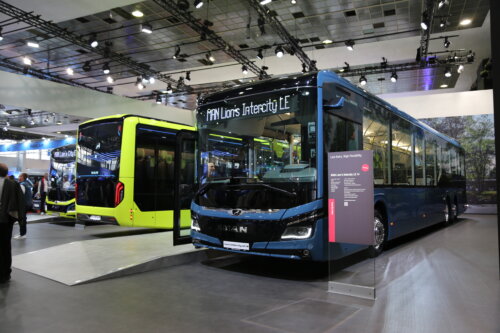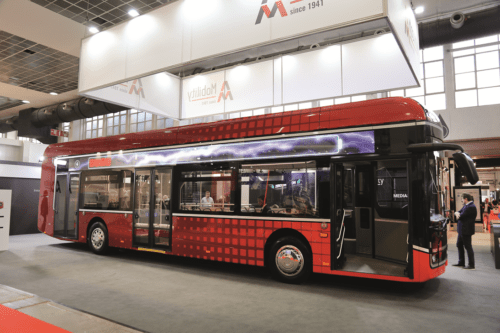Jonathan Welch presents a look at some of the highlights from this year’s Busworld Europe exhibition
(please see our print or digital magazine for the full-length version of this feature)

Held in Brussels for the first time since 2019 after a pandemic-related pause, Busworld returned to the Belgian capital for its 50th event with style and substance in abundance from 7 to 12 October. 526 exhibits, including 75 vehicle manufacturers and 182 newcomers, came from 38 different countries, and were spread over eight halls, linked by 7.8km of corridors. The number of vehicle manufacturers was up by nine compared to the last event in 2019, and the focus on electric buses amongst them was notable; in the mini and coach sector, zero-emission and new energy drivelines were also on display, highlighting the beginning of those sectors’ move away from diesel too.
Inside the halls, 222 vehicles were on display, with a further 29 outside, and alongside the vehicles, suppliers and products on show, a series of conferences covered everything from the Europe-wide driver shortage to driver safety and the future of coach tourism in Europe. Perhaps surprising to those whose interest is solely the UK bus scene, the country with the most number of companies present was Turkiye with 96, followed by Germany with 79, and in third place was China with 61.
This week, we take a look at some of the highlights of the show; we can’t possibly cover everything, so what follows can only be a snapshot of the technology, the vehicles and the people. Some will be familiar names, with updates on latest products and releases, whilst others might be new or unfamiliar, giving a flavour of what is happening in the industry beyond our shores.
Automecanica

Chairman of the Romanian manufacturer, which is new to the whole-bus building scene but has extensive experience of producing bodies for other commercial vehicle manufacturers, Andrei Scobioală presented the company’s new AM12 EB400 electric bus. With a battery capacity of up to 420kWh and the option of NMC or LFP cells, the 12-metre prototype appeared to be a very competent offering, and in its smart two-tone red livery stood out among the many similar buses on show with its full-length LED side displays above the window-line.
Following two years of development on the bus, Andrei outlined the company’s plans to expand its range of whole vehicles to include a tram, a metro and an electric train. He described the firm’s plans as very ambitious, but was confident that it could deliver whole vehicles which are competitive on price and quality, having garnered significant experience of producing frames and bodies for other builders at its 100,000 square feet of combined factory space.
[…]By subscribing you will benefit from:
- Operator & Supplier Profiles
- Face-to-Face Interviews
- Lastest News
- Test Drives and Reviews
- Legal Updates
- Route Focus
- Industry Insider Opinions
- Passenger Perspective
- Vehicle Launches
- and much more!


